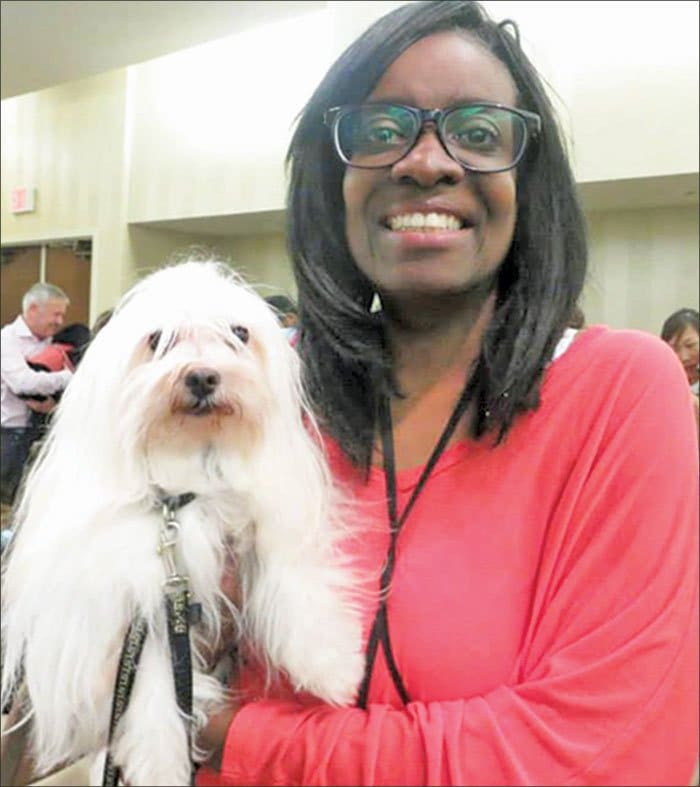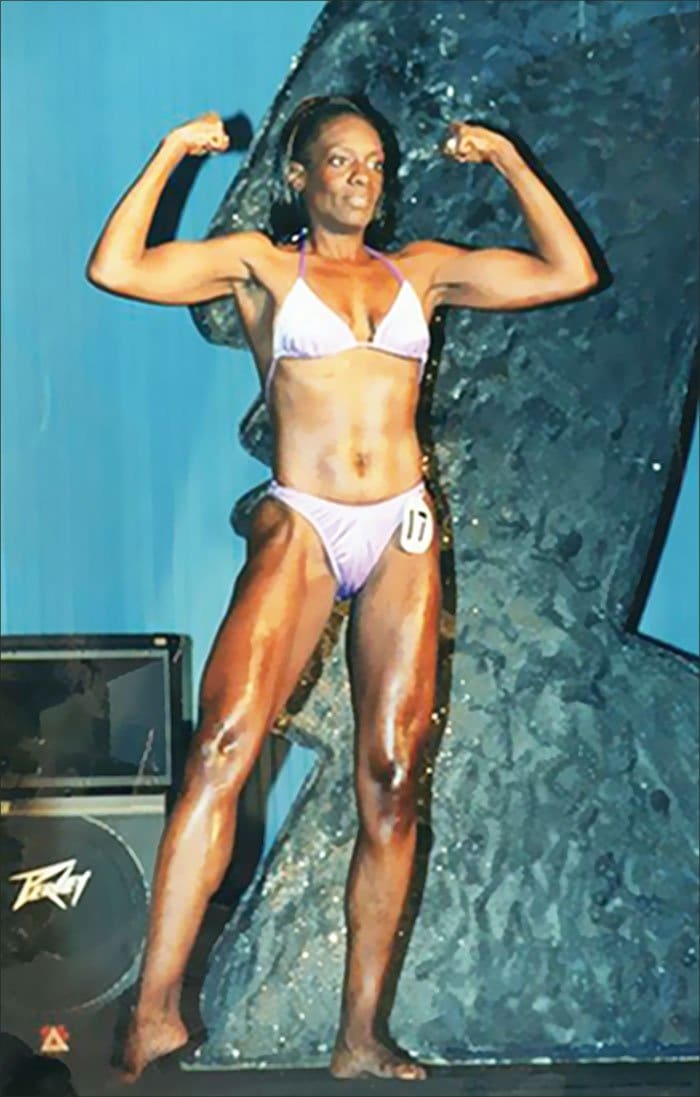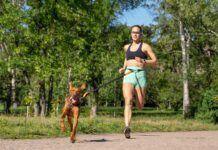I’ve been a dog trainer for more than 25 years. I own my training business, Pup ‘N Iron Canine Fitness & Learning Center in Fredericksburg, Virginia. I’m one of the first dog trainers in Virginia to become a Certified Professional Dog Trainer (CPDT) with the Certification Council of Professional Dog Trainers (CCPDT), and I’m a past Vice-President/Assistant Chair and Board Member of the Association of Professional Dog Trainers (APDT). I’ve written about dogs for dozens of publications, and hosted dog-related radio and Internet shows. I’m an evaluator for AKC Canine Good Citizen dogs and Delta Society Pet Partner therapy dogs, and a licensed judge for AKC, UKC, World Cynosport (formerly APDT) Rally, and C-WAGS Obedience.

The entire time I’ve been working with dogs, I’ve been battling to stay alive. I was diagnosed with lupus when I was 22 – almost 30 years ago! Tests first indicated that my kidneys were failing in 1999 – a complication of the lupus. I was diagnosed with “end stage renal disease,” the technical term for complete, chronic, irreversible kidney failure, almost 15 years ago.
I’ve always hated the term, “end stage”; it seems so final and hopeless. But there’s no way to sugarcoat it: chronic kidney failure is progressive. The deterioration may be slow at times and rapid at others; you can’t be sure of the course it will take. You become increasingly sick and weak as your body becomes unable to remove fluid and toxins, balance electrolytes, regulate blood pressure, and produce red blood cells. You hold on as long as you can until all kidney function is gone and you’re faced with three choices:
– to allow the toxins and fluid to build up and eventually drown within your own body, a very painful, horrific death;
– to have your life sustained by dialysis treatments; or
– to try to get a kidney transplant.
Experienced
I’ve actually been down this road twice. The first time my failing kidneys threatened my life was in 2002. Because my doctors had anticipated my kidney failure, we had a contingency plan in place: my husband Mike, a former Marine and long-time police officer, was a match and would donate one of his kidneys to me! What with one complication and another, however, I had to spend three weeks on dialysis before the transplant surgery could take place. After the surgery was complete in 2003, however, my health returned.
Mike’s kidney sustained me for almost 10 years, before it, too, began failing. So I knew exactly what I was in for – only this time, having only one kidney himself, my heroic husband wouldn’t be able to save me again.
I still had too much living to do – not to mention a village of loved ones who needed and depended on me – so making the decision to seek out only palliative care until my death was not an option for me. Instead, as much as I hated it, I chose to go on dialysis again and start the process of getting on the transplant list.
My village? It includes my beloved dogs, all nine of them, and as time would demonstrate, their presence and quiet support would be instrumental in my journey. My current “pack” consists of four Maltese, a Pharaoh hound, a Standard Poodle, a Dalmatian, a long-haired Chihuahua, and my youngest, a Yorkshire Terrier whom I only recently adopted.

Most of my dogs are seniors: six of them are over 10 years old (including two who are over 12 and two who are over 14!). One of those 12-year-olds is Andrew, my Maltese sweetheart, the dog with whom I appeared on the short-lived (but fun!) 2008 reality TV show on CBS, Greatest American Dog, which was sort of a mix of Survivor and a dog-training camp. Andrew and I placed second in the show’s inaugural season, and were repeatedly praised by the show’s judges for demonstrating the beautiful, mutually respectful relationship that can result from positive, dog-friendly training.
Dreaded Dialysis
Faced with kidney hemodialysis again was terrifying. It consists of being intravenously hooked up to an “artificial kidney” machine and allowing it to remove toxins from your blood and excess fluids from your body. For hours, your blood must repeatedly circulate through the machine’s filters and back into your body. The process is risky and hard on the cardiovascular system. Vital signs must be monitored throughout and at any moment you could go into cardiac arrest. I always found that I was wiped out the following day, unable to work or even do much around the house. It’s estimated that up to 30 percent of people on dialysis die within the first three years, so remaining on it long-term is not desirable.
Unfortunately, for many people, there’s no other option. Even if you are deemed a good candidate for kidney transplantation and put on the United Organ Sharing Network (UNOS) transplant list, it’s a waiting game all over again. There are currently more than 100,000 people waiting for kidney transplants in the United States! Getting a match can take anywhere from four to 10 years, depending on where you live. So the challenge becomes keeping yourself alive on dialysis while you wait.
One of my biggest comforts during this wait was my pack of dogs. Multiple studies and research over the past 25 years confirm the positive effects that pets can have on our overall health and wellbeing. Pet owners suffer fewer minor ailments, such as headaches, colds, and hay fever; pets can help lower blood pressure, reduce anxiety, and boost immunity. There are insurance companies that ask potential clients if they have pets on their initial medical screening questionnaire! Affirmative answers work in the client’s favor. All these factors would influence both my prognosis and decisions I would make about my care.
Because kidneys regulate blood pressure, one of the symptoms of kidney failure is chronic high blood pressure (also known as renal hypertension). Another secondary illness that kidney failure can lead to is congestive heart failure, resulting from excess fluid accumulating in and around the heart and blood vessels. I struggled with both, which landed me in the hospital multiple times. Even though I knew I needed to be in the hospital, I hated it; being hospitalized took me away from my life, my home, my family, my dogs. I knew my doctors would not discharge me until my blood pressure went down.
Each time this happened, it took multiple medications to lower my blood pressure enough so that I could safely go home. I was instructed to continue my medications and monitor my blood pressure throughout the day – which was only ironic because, each time, within hours of being home and with my dogs showering me with love and kisses, my blood pressure returned to normal.
Getting Dialysis Treatment at Home
This repeated experience led me to an important decision regarding dialysis.
Normally, dialysis is performed in clinics, with trained nurses and technicians who insert the IVs, hook up the patients to the dialysis machines, and monitor them during treatment. However, because there are so many people on dialysis (it’s estimated that one in 10 Americans have some level of chronic kidney disease), each patient is limited to only three treatments per week; each treatment lasts two and a half to three hours. In other words, patients are allotted a maximum of nine hours per week on the machines, to accomplish what healthy kidneys do 24 hours a day, seven days a week. So, to be even more frank, dialysis patients normally receive the minimum treatment needed to keep us alive.
Well, the bare minimum was just not acceptable to me. Further, I wanted to be home with my dogs and allow the “pet effect” to work its magic. So my husband (who had recently retired) and I attended six weeks of intense training to become certified to undertake my treatments in our home, on our own, with no medical personnel present. Home dialysis would enable me to undergo dialysis treatment five or six days a week, and for longer periods of time, more closely simulating the work that healthy kidneys do.
Home dialysis is time-consuming, intense, risky – and, yes, a little scary – but being able to receive more dialysis, privately, in the comfort of my own home, and surrounded by my dogs and loved ones, helped me both physically and emotionally. My intention was to be the “healthiest” dialysis patient I could be so I’d be ready for that transplant if and when it came around.
I named my business Pup ‘N Iron in honor of my two big passions in life: body sculpting through weight lifting, and dog training. Before my kidneys failed the first time, I was a full-time personal fitness trainer, and occasionally, even competed in all-natural bodybuilding competitions.
Remember how I said I had struggled with lupus for 30 years? Bodybuilding was a potent weapon against this autoimmune disease. So even though it was difficult when I was so sick and tired, I did my best to work out in between dialysis sessions. I took Zumba and “Body Jam” classes. I did step aerobics and used light hand-held weights. It wasn’t anything near as impressive as what I had done in years past, but given my medical condition, it was just as challenging – and it really helped both my mood and my health.
Putting the Word Out
In addition to waiting on the UNOS list for a suitable transplant match, the only other way to receive a transplant is through a “live” donation.
Humans need only one working kidney; live donation enables a living person to donate one of his or her kidneys to a specified person in need. The donor must be in good health and, of course, must also be “a match” (in terms of blood type and tissue antigens) for the recipient. Donating a kidney is the ultimate altruistic act, and yet thousands like my husband do it – heroes! Out of the 14,000 kidney transplants performed last year, almost 5,000 were from live donations.
The dog community is large, but I’ve found we are all connected in a “six degrees of separation” kind of way – especially today, with the help of social media. Word of my illness and need for a kidney transplant spread quickly throughout the dog world, and amazingly, I started hearing from people who were willing to be tested to see if they were a potential match and could donate a kidney to me! Some were friends, some were only acquaintances, and some – amazingly – were total strangers.
I was profoundly touched each time I heard from another “dog person” who was willing to be a donor. We come from different backgrounds, cultures, races, religions, and socioeconomic levels, but our shared love of dogs somehow binds us – and in this case, saved my life!
Paige Port and I met in 2009 when I hired her to judge a UKC agility trial at my training facility. Paige is a long-time agility competitor, trainer, and judge, and the owner of Hilltop Agility training center in Quinton, Virginia. She is an extremely pleasant person and we shared some laughs and enjoyed interacting with each other that weekend. Later we became Facebook friends and occasionally played Scrabble and Words With Friends online but hadn’t seen each other since.
So I was shocked – and moved and grateful – when she emailed me and offered to be my kidney donor. She began all the necessary testing, and miraculously, she was a match for me!
Our kidney transplant surgeries took place on December 27, 2013 – exactly a year after I had started dialysis for the second time in my life. Now, in addition to being bonded through our love of dogs, we are “kidney sisters” for life. I can’t express how grateful I am to her.
Shortly after the transplantation surgery, when asked why she decided to become my donor, Paige answered, “I thought about it, and talked to my husband about it. It was a pretty easy decision for me to make. I wrote Laurie and said, ‘I’ve got one for you.’ She was a dog person, and I could help.”
Though Paige feels it was an easy decision, I can’t help but feel there was something much more profound at work. Any of us who love dogs know that they soften us. Maybe they were put on this earth not only for us to care for them and find the humanity in ourselves, but to facilitate us in caring for and finding the humanity in each other too.
As I approach the one-year anniversary of my transplant, I continue to advocate for patients with chronic kidney disease and raise awareness about the need for organ donors. Not everyone can or even should be a live donor; however, most can register with their states to be a donor in the event of an untimely death. Thinking about that is certainly unpleasant, but the need for organ donors has never been greater. Thousands of people die each year while waiting for a transplant. One donor can save up to eight lives. What an incredible way to impact the world and what a legacy to leave.
The late writer and television personality Roger Caras once said, “Dogs are not our whole life, but they make our lives whole,” and I am a living example of that. My dogs have not only enriched my life, but through them, I got my whole life back.
A canine education specialist, dog behavior counselor, and trainer, Laurie Williams is the owner and Director of Training and Behavior Counseling at Pup ‘N Iron Canine Fitness & Learning Center in Fredericksburg, Virginia. For more information, see pupniron.com or call (540) 659-7614.
For More Information:
U.S. Dept. of Heath & Human Service organ donation info
This is the primary federal entity responsible for oversight of the organ and blood stem cell transplant systems in the U.S. and for initiatives to increase the level of organ donation in this country (a good central site for information about organ donation). organdonor.gov/about/livedonation.html
Donate Life America
Donate Life America is a 501(c)3 not-for-profit alliance of national organizations and state teams across the United States committed to increasing organ, eye, and tissue donation. donatelife.net





